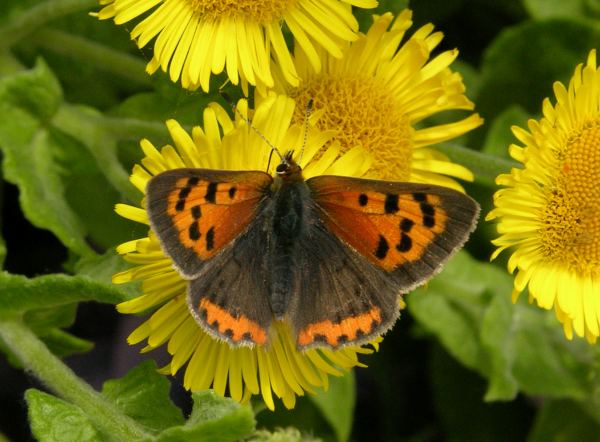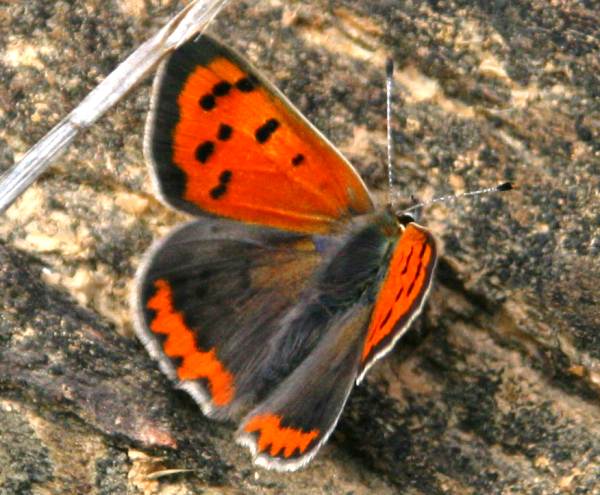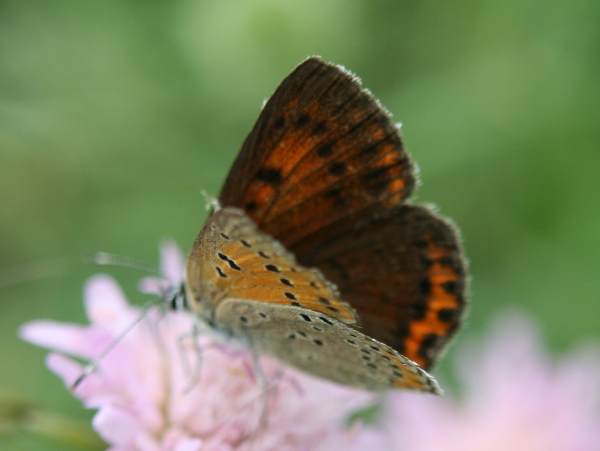Small Copper Butterfly - Lycaena phlaeas
Phylum: Arthropoda - Class: Insecta - Order: Lepidoptera - Family: Lycaenidae

The Small Coppers first appear in March and can be seen right through the summer and autumn, often surviving until the frosts of November.

Description
Unlikely to be confused with any other butterfly found in the UK and Ireland, male and female Small Coppers are similarly coloured and the sexes are difficult to separate without close inspection, both having coppery black-spotted forewings, and much darker hindwings. The wingspan is typically 2.5cm, with the females having more rounded forewings and being slightly larger than the males.

Distribution
The Small Copper, of which there are many subtly different forms in different regions, is found throughout England, Wales and Ireland and occurs less frequently across most of Scotland except the far north. It is also absent from the Outer Hebrides, the Orkneys and the Shetlands. Elsewhere this lovely little butterfly is common and widespread across most of Europe, where its range extends down into North Africa; it is also seen in Asia and in North America.
Habitat
These little butterflies are commonly seen in open grasslands, gardens and riverbanks, but they also inhabit woodland clearings, railway embankments and many other kinds of dryish habitats.
Lifecycle

Eggs are laid singly on the upperside of the leaves of the foodplant - mainly Common Sorrel Rumex acetosa - and the smaller Sheep's Sorrel Rumex acetosella, although other kinds of docks may also be used occasionally.

Once the caterpillars emerge from the eggs they move to the underside and feed there. The distinctive green-and-pink larvae of the Small Copper leave conspicuous window-like transparent areas where they have eaten all but the tough upper epidermis of the leaf. This is one of the butterfly species that overwinters in its caterpillar state.
In the spring, pupation takes place among the grassland leaf litter, and some authorities say that the pupae are tended by ants.
Following the spring brood there are usually one or two further broods and, in the southern part of its distribution, sometimes a fourth brood as late as November.

Etymology
The origin of the specific epithet phlaeas is disputed, but it may come from the Greek phlégo, meaning 'to burn up' - a reference to the flame-coloured wings.
Acknowledgements
This page includes pictures kindly contributed by Betty and Tony Rackham.
Studying butterflies and moths...
Excited at the prospect of flyfishing? So are we, and we're pretty sure you would find the Winding River Mystery trilogy of action-packed thrillers gripping reading too. Dead Drift, Dead Cert, and Dead End are Pat O'Reilly's latest river-and-flyfishing based novels, and now they are available in ebook format. Full details on our website here...
Buy each book for just £4.96 on Amazon...
Please Help Us: If you have found this information interesting and useful, please consider helping to keep First Nature online by making a small donation towards the web hosting and internet costs.
Any donations over and above the essential running costs will help support the conservation work of Plantlife, the Rivers Trust and charitable botanic gardens - as do author royalties and publisher proceeds from books by Pat and Sue.
